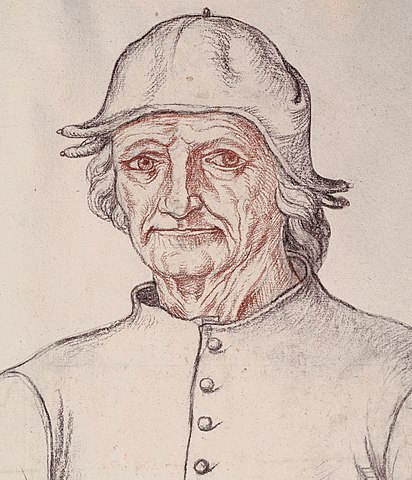
Born: c. 1450, Brabant
Died: Buried 9 August 1516 (aged (65-66)
Period: Early Renaissance
The Life of Hieronymus Bosch
Hieronymus Bosch, born Jheronimus van Aken, was a Northern European painter of the late Middle Ages whose work is known for its unique and intricate detailing, fantastical imagery, and deep symbolism. Bosch was born and lived in ‘s-Hertogenbosch, a city in the Duchy of Brabant (now the Netherlands), from which he derived his name “Bosch”. Very little is known about his life, his training, or the influences on his art, making Bosch a somewhat enigmatic figure. Despite the scarcity of documented facts about his personal life, his surviving works provide a wealth of insight into his innovative and complex visual language.
Bosch’s paintings are characterized by their elaborate scenes of religious concepts and narratives, moral and philosophical allegories, and depictions of heaven and hell that teem with surreal and grotesque creatures. His most famous work, “The Garden of Earthly Delights,” is a triptych that has been interpreted in numerous ways but is generally seen as a warning of the dangers of giving in to temptation. This work, like many of his others, showcases Bosch’s skill in rendering detail, his vivid imagination, and his interest in humanity’s sins and follies.
Unlike many of his contemporaries, Bosch’s work was less concerned with the precise representation of religious themes according to doctrinal specifics and more with illustrating moral and allegorical tales that caution against vice and encourage virtue. His work is often seen as a bridge between the medieval world and the Renaissance, combining the detail and symbolism of Gothic art with emerging humanist ideas.
Bosch was a member of the Illustrious Brotherhood of Our Blessed Lady, a religious confraternity that included some of the most influential citizens of ‘s-Hertogenbosch. This connection may have helped him secure commissions and establish his reputation. After his death, Bosch’s works continued to influence and inspire, enjoying a revival of interest in the 20th century, particularly among Surrealists who admired his ability to depict the subconscious and his visionary approach to painting.
Today, Hieronymus Bosch is celebrated for his imaginative and complex compositions, his exploration of the human condition, and his unparalleled ability to depict the fantastical and the grotesque. His paintings remain objects of fascination, study, and admiration, standing as testament to his unique place in art history.
Hieronymus Bosch’s Notable Works
Hieronymus Bosch, a pivotal figure in the history of Western art, is renowned for his detailed and symbolic works that explore themes of morality, sin, and redemption through fantastical and often bewildering imagery. Here are ten of Bosch’s most famous and influential works:
- The Garden of Earthly Delights (c. 1490–1510) – A triptych that is Bosch’s most famous work, depicting a progression from the Garden of Eden through a landscape of earthly pleasures to a hellish scene of damnation and torment.
- The Haywain Triptych (c. 1516) – This triptych allegorically portrays the folly of humankind’s obsession with the material world, centered around a large hay wain, or cart, which people attempt to claim, leading them towards damnation.
- The Last Judgment (c. 1482) – A monumental triptych depicting the end of the world and the judgment of souls, showcasing Bosch’s vivid imagination in the portrayal of heaven, earth, and hell.
- The Temptation of St. Anthony (c. 1501) – A series of panels that depict the saint’s visions and temptations in the desert, filled with bizarre and grotesque creatures, showcasing Bosch’s ability to convey complex religious themes through surreal imagery.
- Ship of Fools (c. 1490–1500) – A painting that satirizes the folly of mankind, depicted through a group of foolish people aboard a boat, a theme that resonates with Bosch’s interest in human vice and moral instruction.
- The Seven Deadly Sins and the Four Last Things (c. 1485) – A circular table-top painting that illustrates the seven deadly sins around the perimeter, with depictions of Death, Judgment, Heaven, and Hell in the center, serving as a moral compass.
- The Adoration of the Magi (c. 1494) – A triptych depicting the biblical story of the Magi visiting the newborn Christ, with Bosch’s characteristic attention to detail and inclusion of symbolic, often ominous, elements.
- The Pedlar (c. 1500) – Also known as “The Wayfarer,” this panel is interpreted as representing the journey of life with its various temptations and pitfalls, depicted through the figure of a traveler navigating through a chaotic landscape.
- St. John the Baptist in the Wilderness (c. 1489) – A panel showcasing St. John in a serene yet detailed landscape, contrasting with Bosch’s more chaotic compositions and highlighting his versatility as an artist.
- St. Jerome in Prayer (c. 1482) – A work that depicts St. Jerome in a meditative state in a tranquil landscape, reflecting Bosch’s ability to create contemplative religious scenes alongside his more tumultuous compositions.
Hieronymus Bosch’s work continues to captivate and puzzle audiences with its intricate details, complex symbolism, and the artist’s profound imagination. His legacy is one of creativity and innovation, leaving a lasting impact on the visual arts and beyond.